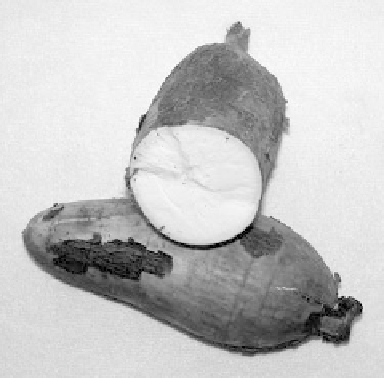Agriculture Reference
In-Depth Information
commercial fertilizer. Much of the world production of cassava is on small areas by
farmers who do not have access to inputs, and thus fertilization of cassava using
commercial fertilizers is not common.
5.6.4 Diseases, Insects, and Their Control
Cassava is subject to attack by viruses, fungi, and bacteria, including root rots just as are
tuber crops. Mites, mealybug, and grasshoppers attack plant leaves and can cause
decreases in yield. As with other tuber crops, crop rotation and disease-free planting
material can decrease the incidence of disease.
Diseases, insects, and poor cultural practices can lead to large reductions in har-
vested portions of the crop. Most planting materials are obtained locally and from pre-
vious crops because there is no commercial, disease-free, source of these materials.
Thus, since cassava is propagated by stem cuttings, the careful selections of stems to
be used for subsequent crops is an effective method of limiting these types of losses.
5.6.5 Harvesting and Storage
Cassava will continue to grow even after the roots have reached their maximum size.
Thus harvesting is not a question of allowing the plants to mature but of when the
maximum root production has occurred. This will be different in different localities,
but often plants are allowed to grow from 8 to 16 months. If grown for longer
periods of time, roots may become fibrous and thus not desirable for use as a food
source. Harvesting involves cutting the tops off and pulling the roots; once harvested,
roots do not store well, especially in the tropical conditions where it is most frequently
grown. Thus roots are dried and cooked within a few, 2 to 3, days of harvest and used as
food or dried to produce cassava flour.
Figure
5.18.
Cassava showing white interior.









